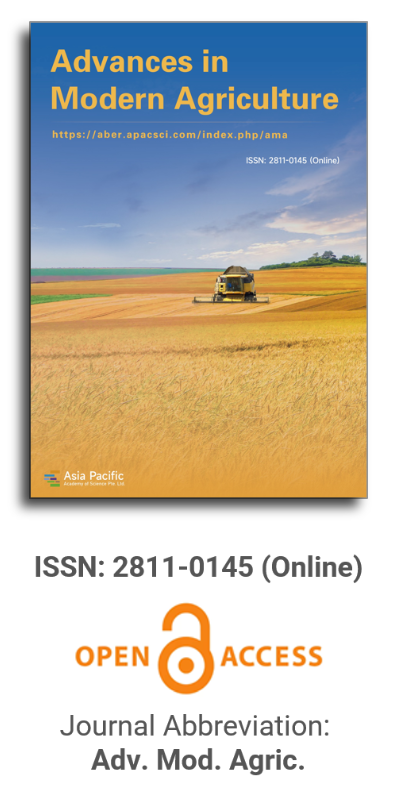


Urban agriculture empowerment: Donkey-driven maize planter for sustainable food production in Sub-Saharan African cities
Vol 4, Issue 2, 2023
VIEWS - 3935 (Abstract)
Download PDF
Abstract
The lack of affordable and lightweight mechanized maize planters suitable for small-scale farms in Botswana, where donkeys serve as the primary source of draught power, poses a significant challenge. This study addresses this issue by designing a cost-effective model of a two-row donkey-drawn maize planter. A comprehensive analysis of various existing planter technologies was conducted, and their principles were carefully adapted to develop an optimal two-row planter suitable for donkey traction. The selection of appropriate materials for each component, accompanied by the use of SolidWorks software for detailed drawings and fabrication, resulted in a user-friendly planter design. The mass estimation of the assembled planter was calculated to be 48.93 kg, making it light enough to be drawn by three donkeys. Notably, the estimated cost of the unit planter assembly is approximately 200 USD. Despite these advancements, it is important to acknowledge certain limitations. This study introduces an innovative solution to address the need for affordable, lightweight, and donkey-drawn maize planters in Sub-Saharan Africa. By leveraging existing technologies and employing appropriate materials, the proposed design offers a practical and cost-effective option for small-scale farmers. Further research is necessary to assess the planter’s performance under varying soil conditions, evaluate its long-term durability, and optimize its planting efficiency. Additionally, consideration should be given to implementing additional features such as seed depth control mechanisms and adjustable row spacing to enhance the versatility of the planter.
Keywords
References
- Soyoye BO, Ademosun OC, Agbetoye LAS. Determination of some physical and mechanical properties of soybean and maize in relation to planter design. Agricultural Engineering International: CIGR Journal 2018; 20(1): 81–89.
- Mkomwa S, Kaumbutho P, Makungu P. Farm machinery for conservation agriculture. In: Farooq M, Siddique K (editors). Conservation Agriculture. Springer; 2014. pp. 109-131. doi: 10.1007/978-3-319-11620-4_5
- Rajavel S, Rajeshkumar R, Pramjin P, et al. Design and fabrication of seed in planter by conversion of energy. International Journal of Engineering Research & Technology 2018; 6(4): 4–7. doi: 10.17577/IJERTCONV6IS04085
- Soyoye BO. Design and evaluation of a motorized multi-grain crop planter. Agricultural Engineering International: CIGR Journal 2020; 22(1): 54–66.
- García de Jalón S. Participatory process: Approaches for assessing farmer behavior towards adopting climate change adaptation strategies in Sub-Saharan Africa. In: Quiroga S (editor). Economic Tools and Methods for the Analysis of Global Change Impacts on Agriculture and Food Security. Springer; 2018. pp. 61-86. doi: 10.1007/978-3-319-99462-8_5
- Eke CNU, Asoegwu SN, Nwandikom GI. Some physical properties of jackbean seed (Canavalia Ensiformis). Agricultural Engineering International: CIGR Journal 2017; 1: 1–11.
- Abebe F. Development and evaluation of animal-drawn. Single Row Tillage-Cum-Multicrop Planter 2018; 6: 500–508. doi: 10.14662/ARJASRD2018.083
- Moepeng P. Rural development in Botswana: Experiences from elsewhere and emerging issues. Available online: https://ageconsearch.umn.edu/record/152685/?v=pdf (accessed on 2 May 2023).
- Ricci T. Jethro Tull. Available online: https://www.asme.org/topics-resources/content/jethro-tull (accessed on 2 May 2023).
- Kubik R. How to Use Implements on Your Small-Scale Farm. Voyageur Press; 2005.
- Valavanidis A, Vlachogianni T. Homo sapiens’ energy dependence and use throughout human history and evolution. Available online: https://www.researchgate.net/publication/303370977_Homo_Sapiens'_Energy_Dependence_and_Use_Throughout_Human_History_and_Evolution (accessed on 2 May 2023).
- Charles V. Mapes. Illustrated Catalogue of Plows, and Other Agricultural Implements and Machines. M’Crea & Miller; 1861.
- Ganzel B. Planter technology. Available online: https://livinghistoryfarm.org/farminginthe50s/planter-technology/ (accessed on 2 May 2023).
- Ganzel B. Planter technology. Available online: https://livinghistoryfarm.org/farminginthe50s/machines_10.html (accessed on 2 May 2023).
- Rabbani MA, Hossain MM, Asha JF, et al. Design and development of a low-cost planter for maize establishment. Journal of Science Technology and Environment Informatics 2016; 4(1): 270–279. doi: 10.18801/jstei.040116.30
- Zhao Y, Xing S, Zhang Q, et al. Causes of maize density loss in farmers’ fields in Northeast China. Journal of Integrative Agriculture 2019; 18(8): 1680–1689. doi: 10.1016/s2095-3119(18)62101-x
- Mosmar S, Ah-mmed A, Maize I. Design and development of a power tiller operated inclined plate multi-crop planter. Journal of Agricultural Engineering 2004; 31(1).
- Ani O, Uzoejinwa B, Anochili N. Design, construction and evaluation of a vertical plate maize seed planter for gardens and small holder farmers. Nigerian Journal of Technology 2016; 35(3): 647. doi: 10.4314/njt.v35i3.25
- Gbabo IA, Simeon M. Design, fabrication and testing of a tractor drawn soybean planter. FUW Trends in Science & Technology Journal 2017; 2(1B): 562–568.
- Bamgboye AI, Mofolasayo AS. Performance evaluation of a two-row okra planter. Agricultural Engineering International: CIGR Journal 2006; 1–10.
- Khan K, Moses SC, Kumar A. The Design and fabrication of a manually operated single row multi-crops planter. IOSR Journal of Agriculture and Veterinary Science 2015; 8(10): 2319–2372.
- Edeh J, Johnson I. Development and performance evaluation of a manually operated cowpea precision planter. International Journal of Engineering and Technology 2014; 4(12): 693–699
- Bonsu PO, Omae H, Nagumo F, et al. Evaluation of two jab planters for planting maize in the forest zone of Ghana. International Journal of Innovation and Applied Studies 2015; 10(1): 30–35.
- Food and Agriculture Organization of United Nation. Animal Traction and Single-Axle Tractor Drawn Planters in Conservation Agriculture. Food and Agriculture Organization of United Nation; 2014.
- Acquah BK. Making technologies work for resource poor farmers Botswana. Botswana Journal of African Studies 2003; 17(2): 78–84.
- Obingene MC. The Role of Extension Workers in the Provision of Information to Small-Scale Crop Farmers in Oji-River Local Government Area, Enugu State, Nigeria [Master’s Thesis]. University of Botswana; 2015.
- Teca. Jab planter user manual. Available online: https://teca.apps.fao.org/teca/fr/technologies/7339 (accessed on 2 May 2023).
- Agarwal A, Seretse OM, Letsatsi MT, Dintwa E. Review of energy status and associated conservational issues in Botswana. Matec Web of Conferences 2018; 172. doi: 10.1051/matecconf/201817206003
- Michael D, Orzolek, Donald R. Effect of planting equipment and techniques on seed germination and emergence: A review. Association of Official Seed Analysts and the Society of Commercial Seed Technologists 1984; 9(2): 99–113.
- Lapedes DN. Mcgraw-Hill Dictionary of Scientific and Technical Terms, 2nd ed. Mcgraw-Hill; 1978.
- Robert W. Technical Note 21. Soil, Draft, and Traction. Agrospere International Group; 2016.
- Ali M. Design and development of a multi-crop manual seed drill. Agricultural Engineering International: CIGR Journal 2019; 21: 51–60.
Supporting Agencies
Copyright (c) 2023 O.M. Seretse, Abhishek Agarwal, Ulaula Mmiletsi, Mbizo Mpho
License URL: https://creativecommons.org/licenses/by/4.0/

This site is licensed under a Creative Commons Attribution 4.0 International License (CC BY 4.0).

Prof. Zhengjun Qiu
Zhejiang University, China

Cheng Sun
Academician of World Academy of Productivity Science; Executive Chairman, World Confederation of Productivity Science China Chapter, China
Indexing & Archiving
In the realm of modern agriculture, the integration of cutting-edge technologies is revolutionizing the way we approach sustainable farming practices. A recent study published in Advances in Modern Agriculture titled "Classification of cotton water stress using convolutional neural networks and UAV-based RGB imagery" has garnered significant attention for its innovative approach to precision irrigation management. Conducted by researchers from Institute of Data Science and the AgriLife Research and Extension Center of Texas A&M University (authors's information is below). This study introduces a novel method for classifying cotton water stress using unmanned aerial vehicles (UAVs) and convolutional neural networks (CNNs), offering a powerful solution for optimizing water use in agriculture.
Modern agricultural technology is evolving rapidly, with scientists collaborating with leading agricultural enterprises to develop intelligent management practices. These practices utilize advanced systems that provide tailored fertilization and treatment options for large-scale land management.
This journal values human initiative and intelligence, and the employment of AI technologies to write papers that replace the human mind is expressly prohibited. When there is a suspicious submission that uses AI tools to quickly piece together and generate research results, the editorial board of the journal will reject the article, and all journals under the publisher's umbrella will prohibit all authors from submitting their articles.
Readers and authors are asked to exercise caution and strictly adhere to the journal's policy regarding the usage of Artificial Intelligence Generated Content (AIGC) tools.
Asia Pacific Academy of Science Pte. Ltd. (APACSCI) specializes in international journal publishing. APACSCI adopts the open access publishing model and provides an important communication bridge for academic groups whose interest fields include engineering, technology, medicine, computer, mathematics, agriculture and forestry, and environment.



.jpg)
.jpg)

.jpg)
